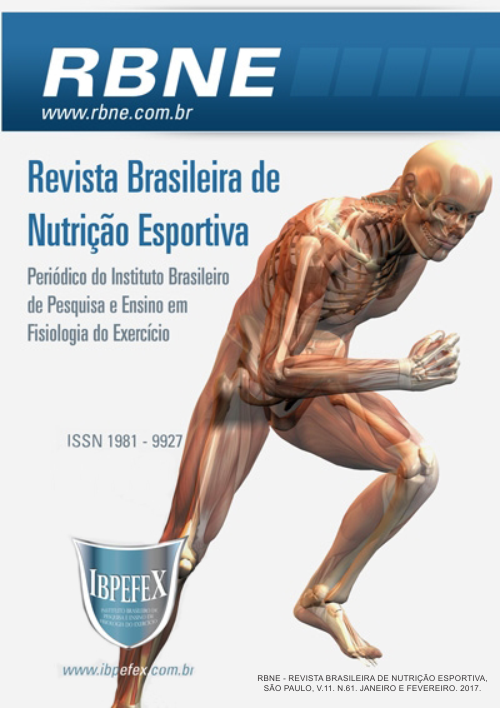Frequency and Preference of beef meat Consumption, Swine and Poultry in Practitioners of Physical Exercise on the Academies Redenção-Pará
Abstract
The meat is a nutrient that deserve special emphasis on food. According to recent data, poultry, beef and pork, respectively are the most consumed in Brazil. The physically active tend to associate the increase in body mass and muscle to greater consumption of proteins. The meats have large amounts of protein and have a high digestibility beyond the nine essential amino acids that humans need for their growth and development. The objective of this paper was to determine the frequency and meat consumption preference for practitioners of physical exercise four academies City Redenção-Pará. For this, we applied a questionnaire to 50 regulars academies which 18 men and 32 women. Results showed that beef and chicken showed 58% of frequent consumption and pork being consumed less frequently by patrons with values of 46%, this fact may be related to the custom of the region, beliefs, superstitions and diets these goers follow. According to data obtained in the survey it was observed that the consumption of meat by most people who attend the academies is directly related to the quality of the meat they consume, this fact is due to diets that are submitted or even issues health and preference. Despite the chicken meat is the most consumed in Brazil, beef still good consumer acceptance.
References
-ANUALPEC. Anuário da Pecuária Brasileira. São Paulo. Instituto FNP. 2007. 368 p.
-Caparros, D. R.; Stulback, T. E.; Nunes, C. P.; Rodrigues, V. C. J.; Barros,A. Z. Ingestão Proteica de Praticantes de Musculação de uma Academia do Município de Santo André. Revista Digital. Vol. 14. Núm. 132. p. 1-14. 2009.
-Costa, W.S. A Avaliação do Estado Nutricional e Hábitos Alimentares de Alunos Praticantes de Atividade Física de uma Academia do Município de São Bento do Una-PE. Revista Brasileira de Nutrição Esportiva. São Paulo. Vol. 6. Núm. 36. p. 464-469.2012. Disponível em: <http://www.rbne.com.br/index.php/rbne/article/view/344/348>
-CONAB. Indicadores da Agropecuária: Quadro de Suprimentos. Disponível em <http://www.conab.gov.br/conteudos.php> Acesso em 16/10/2015.
-Macedo, L. M. A.; e colaboradores. Composição Química e Perfil de Ácidos Graxos de Cinco Diferentes Cortes de Novilhas Mestiças (Nelore vs Charoles). Semina. Vol. 29. Núm. 3. p. 597-608, 2008.
-Neves, M. F. Estratégias para a Carne Bovina no Brasil. São Paulo. Ed. Atlas. 2012.
-Nunes, L. M.; Jesus, L. M. N. Aspectos Nutricionais e Alimentares de Jogadores de Futebol em um Clube Esportivo de Caxias do Sul-RS. Revista Brasileira de Nutrição Esportiva. São Paulo. Vol. 4. Num. 22. p. 314-323. 2010. Disponível em: <http://www.rbne.com.br/index.php/rbne/article/view/196/190>
-Panza, V. P.; e colaboradores. Consumo Alimentar de Atletas: Reflexões sobre Recomendações Nutricionais, Hábitos Alimentares e Métodos para Avaliação do Gasto e Consumo Energéticos. Rev. Nutr. Vol. 20. Núm. 6. 2007.
-Rodrigues. Pesquisa de Mercado: Hábitos de Consumo e Perfil do Consumidor de Carne Bovina In Natura na Grande Vitória. Vitória. 2009.
-Souza, L. G.; e colaboradores. Consumo de Doces, Refrigerantes e Bebidas entre Adolescentes no Munícipio de Salvaterra na Ilha do Marajó-PA. 10º Simpósio latino americano.2013.
-Velho, J. P.; e colaboradores. Disposição dos Consumidores Porto-Alegrenses à Compra de Carne Bovina com Certificação. Revista Brasileira de Zootecnia. Vol. 38. Núm. 2. p. 399-404. 2009.
Authors who publish in this journal agree to the following terms:
- Authors retain the copyright and grant the journal the right of first publication, with work simultaneously licensed under the Creative Commons Attribution License BY-NC which allows the sharing of the work with acknowledgment of the authorship of the work and initial publication in this journal.
- Authors are authorized to enter into additional contracts separately for non-exclusive distribution of the version of the work published in this journal (eg, publishing in institutional repository or book chapter), with acknowledgment of authorship and initial publication in this journal.
- Authors are allowed and encouraged to post and distribute their work online (eg, in institutional repositories or on their personal page) at any point before or during the editorial process, as this can bring about productive change as well as increase impact and impact. citation of published work (See The Effect of Free Access).






